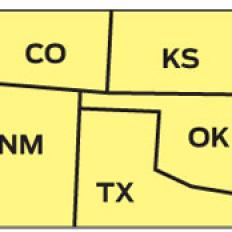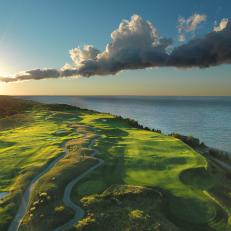The Ultimate Summer Road Trip
Playing golf from sunup to sundown is something I dream about often. Few things sound more exciting. So when my sister, Kira, suggested we take a golf trip that included hiking, I asked myself, "Why wouldn't we just play golf the entire time?" Then I thought about it. Golf is a great way to explore a new city and experience the outdoors, and so is hiking. Combining the two activities probably offers a more well-rounded adventure and and a break from monotony. Kira and I invited two friends, Andrew Kipper and Tom Freeman, and set off on a golf trip that kept us enthralled from start to finish.
Before I begin retelling the story of our road trip, I'd like to introduce the golfers/hikers who joined me. From left to right are: Andrew Kipper, a 30-year-old sports agent who works at Excel Sports Management. He lives in Manhattan and served as our alarm most mornings, since he was answering phone calls at 6am. He has a 6 handicap. I'm next! I'm 28 years old and, like Andrew, I live in Manhattan. I've been working at Golf Digest for more than seven years. It's as dreamy as it sounds. I have a 4 handicap. The guy to my right is Tom Freeman, a 28-year-old lobbyist who lives in Minneapolis. He's one of the few people I know who's more into golf than I am. He and I "compete" every weekend, even when he tees it up in Minneapolis and I play in the New York metro area. I rarely beat him. He has a 3 handicap. Standing to Tom's right is Kira Mayo, my lovely twin sister and a dermatology resident at the University of Rochester. She and I played golf at the University of Virginia, and she's the current club champion at Locust Hill Country Club. She has a 4 handicap.
Our road trip officially began on Memorial Day Saturday (May 24th) at 8:30am on the first tee at Maderas Golf Club ($210 for residents; $165 for residents). A newcomer to Golf Digest's ranking of America's 100 Greatest Public Golf Courses, Maderas bends around the mountains of north San Diego and offers plenty of visually-stunning golf holes that rise and fall and twist and turn.
As you can see from this par-3 15th hole, the elevation changes at Maderas are dramatic and beautiful. It's a Johnny Miller and Robert Muir Graves design that makes you feel as though you've snuck onto a private track.
Here's the par-5 18th hole at Maderas, a fun final hole that can yield a birdie as easily as it could a double bogey. After your round, order a glass of the roasted pineapple martini and a serving of the fish tacos. Just thank me later.
Immediately after our leaving Maderas, my crew and I drove back to the Lodge at Torrey Pines, our home base during our stay in San Diego. Several rooms at the Lodge offer unobstructed views of the 18th green at Torrey South. Here's what my morning cup of coffee looked like. Bliss.
After changing into workout clothes, the four of us walked from our room at the Lodge to the hiking trails at the Torrey Pines State Reserve.
Getting to this point from the Lodge requires just a 30-minute walk.
There are multiple trails from which to choose at Torrey Pines State Reserve, and most of them lead down to the Pacific Ocean. Tom used a FitBit to track the number of steps he took each day, and I used a Jawbone. On this first day, between playing Maderas and hiking at Torrey Pines, he took 29,000 steps and walked 13.45 miles. I took 31,000 steps and walked 14.7 miles.
At 7:50am on Sunday morning, Kira, Tom, Andrew and I teed off at Torrey Pines' South Course ($230 for non-residents; $76 for residents). The third tee offers the first close-up look at the Pacific Ocean. Locals tell me that fog typically obstructs a clear view of the flagstick, but not on the day we played. This third green is visible from many holes throughout the course.
Renovated in 2001 by Reese Jones in preparation for the 2008 U.S. Open, several holes at Torrey South offer dramatic views of the Pacific. Here's the green on the par-4 fourth hole.
The approach to the par-4 12th hole at Torrey South is simply stunning.
The 14th hole at Torrey South is another long par 4 that sits on a cliff. Tom and Andrew played Torrey South from the blue tees, which stretches to 7,051 yards. Kira and I played from the gold tees, which plays to 6,153 yards. It was a tough test for all of us. Using his FitBit, Tom was able to calculate that he took 16,200 steps at Torrey and walked 8.1 miles. Using my Jawbone, I saw that I took 16,500 steps and walked 7.7 miles.
Right after our round at Torrey South, we packed up and hit the road. It was important for us to find a car that comfortably accommodated the four of us, as well as all of our golf and hiking gear. This Ford Expedition was the perfect answer. It even had enough outlets and USB ports to ensure our phones and laptops stayed charged. We named her Rhonda.
Even though driving up Pacific Coast Highway added about two hours to our drive from San Diego to Monterey, it offered amazing views. Here, we stopped somewhere near Santa Monica to savor the breeze and hit biodegradable golf balls into the Pacific.
After piling into a Marriott and getting less than six hours of sleep, we teed it up at the newly-renovated Poppy Hills ($210; $75 for Northern California Golf Association members). We hadn't played Poppy Hills before the renovation, but in its current state it reminded me of a mix between Bandon Trails (beautifully tree-lined fairways) and Pine Valley (gorgeous bunkering from tee to green). Here's the second hole, a long par 3 that has an insanely difficult green.
Beautiful tree stumps mark every hole at Poppy Hills.
Part of the renovation at Poppy Hills included removing all rough. As you can see here (the fourth tee), the course's defense lies in lots of bunkering and fescue and heavily tree-lined fairways.
Here's the view of the par-3 15th hole from the tee. Now you know why it reminds me of Bandon Trails and Pine Valley.
Right after our round at Poppy Hills, we drove down 17-Mile Drive, a scenic road through Pebble Beach that hugs the Pacific Ocean, en route to our hotel room. The drive is a must-do activity for anyone who's in Monterey. Tom, shown here, is a sap for scenic shots.
Here's what the 14th hole at Monterey Peninsula's Dunes Course looks like from 17-Mile Drive.
The afternoon after playing Poppy Hills, we drove about 15 minutes south to Point Lobos State Natural Reserve. The hike began with typical trails . . .
. . . but these typical trails quickly lead to magnificent views of Monterey and Pebble Beach. Point Lobos is one of the most beautiful, untouched areas we'd ever seen, complete with coves, rolling terrain and coastal rocks. It was serene and breathtaking.
At Point Lobos, we were able to walk right onto the coast and get close to seals, sea lions and sea otters. According to his FitBit, Tom knew he took 18,600 steps on the day we played Poppy Hills and hiked at Point Lobos. That totaled 8.9 miles. I took 21,300 steps and walked 9.3 miles.
On Tuesday morning, we drove an hour north, from Monterey to Santa Cruz, to tee it up at Pasatiempo ($260; $120 replay rate). Most of the greens here drape into bunkers, like the par-3 fifth green, shown here.
Often considered the best Alister Mackenzie design available to the general public, Pasatiempo's magic lies in its greens and the bunkers that protect them. Just check out the par-4 10th.
The variety of shots is what I love most about Pasatiempo. Every green falls differently and dramatically. The three-tiered 16th green, shown here, epitomizes this drama.
Pasatiempo's five par 3s are magnificent, and they include this finishing hole, which forces you to fly over a barranca and onto an undulating, two-tiered green. Before leaving the course, make sure you check out the tribute made to Alister Mackenzie just outside the pro shop. In it, you'll see Mackenzie's "Dream 18", which includes the first and 14th holes at Pasatiempo, among other greats, like the 12th hole at Augusta and the 16th at Cypress Point.
As soon as we finished our round at Pasatiempo, we piled into our Ford and drove 90 minutes north, to San Francisco. Here's where we watched the sun set. On this day, Tom took 18,100 steps and walked 8.7 miles. I took 17,900 steps and walked 8.5 miles.
The following morning, we laced up our sneakers and headed to Lands End, a rocky trail located in the northwest corner of San Francisco.
Our hike at Lands End, which lasted about an hour and a half, was complete with cypress trees, pocket beaches and views of the Golden Gate Bridge.
The coastal areas of Lands End were a great place to stop and reflect.
Soon after exploring the beautiful hillsides of Lands End, we drove into TPC Harding Park ($175 for non-residents; $66 for residents), a municipal course located on Lake Merced. Here's what the par-4 14th looks like from behind the green. The tee on this hole offers a clear view of The Olympic Club, which also sits on Lake Merced. The two courses share the same designer, Willie Watson.
Harding Park has an everyone-is-welcome kind of feel, and its atmosphere reminded me of Bethpage in its minimalism -- an understated pro shop and restaurant over-deliver in quality and service. There's a lot of history at Harding, as Ken Venturi, Billy Casper, Gary Player, and Tiger Woods have all won there, and it's a fun, challenging track that is lined with the most intriguing trees. Shown here is the 12th green.
More so than the front nine, the back nine at Harding Park is a beautiful test of golf, and the par-4 18th is one of the toughest, most demanding finishing holes I've played. It was the perfect end to our five-course journey up the West Coast. After hiking at Lands End and playing at Harding, Tom took 21,400 steps and walked 10.4 miles. I took 20,600 steps and walked 9.8 miles.
The four of us will always cherish how awesome it was to experience three California cities by way of five amazing golf courses and three beautiful hikes. Grab three friends and try something similar. You won't regret it.






